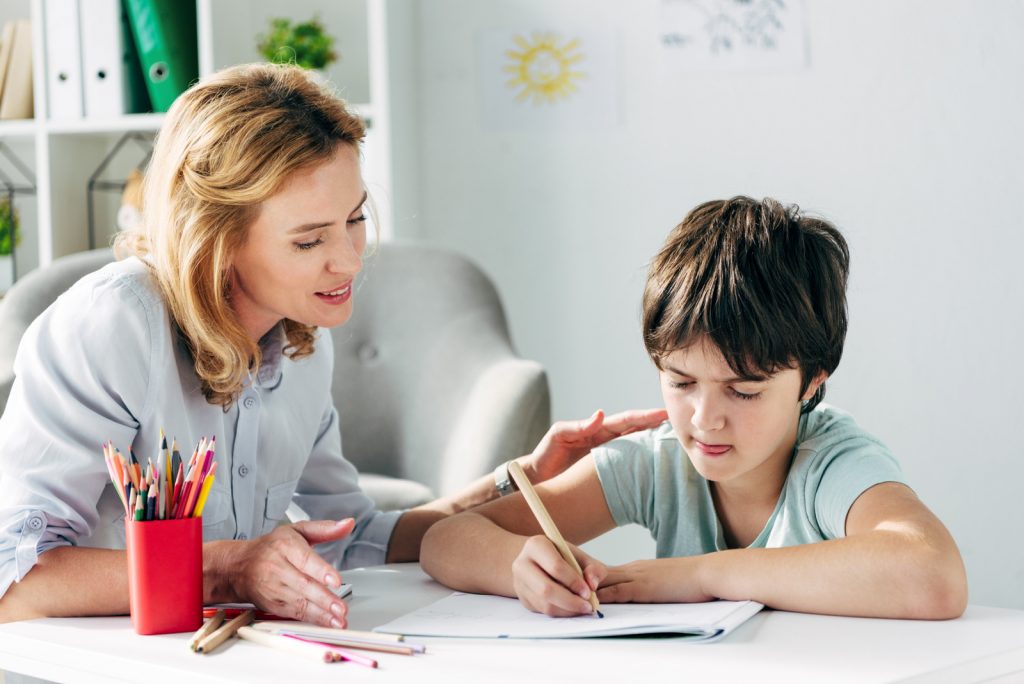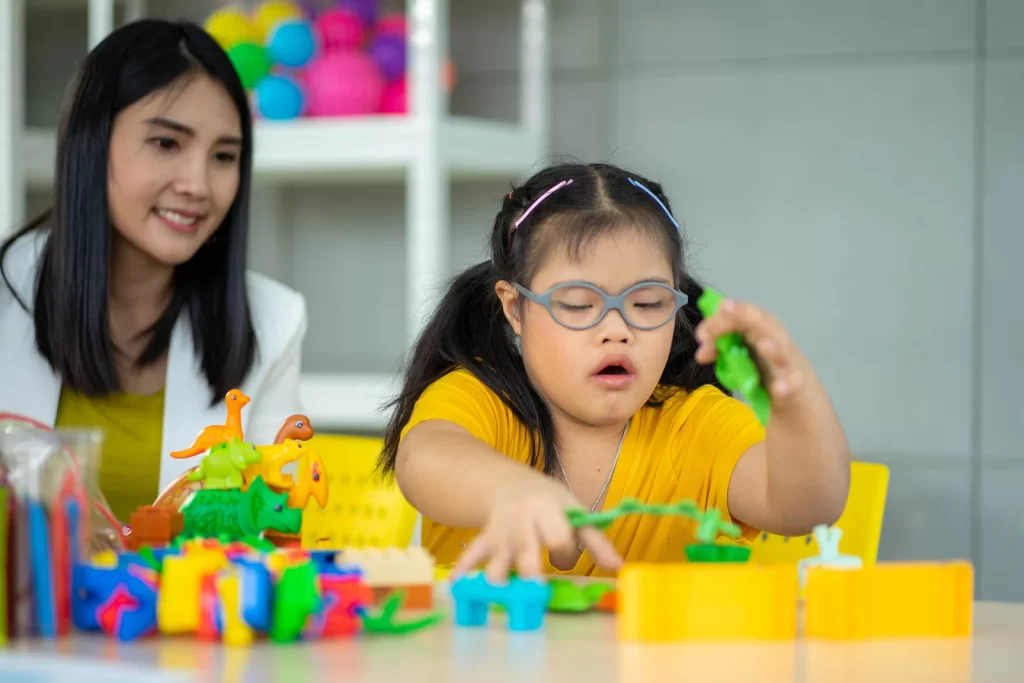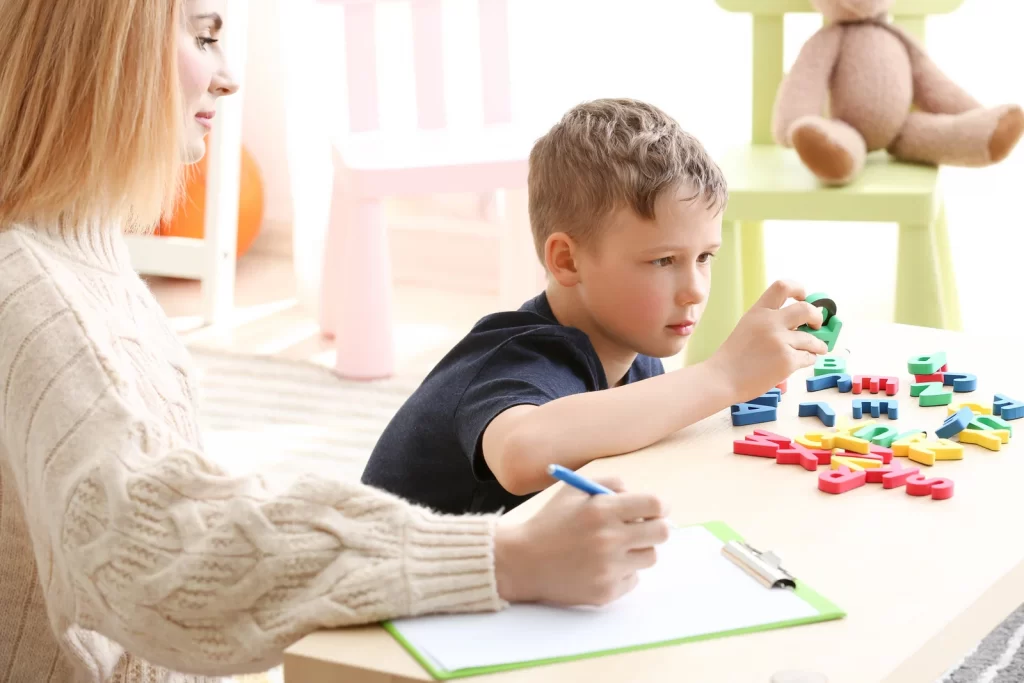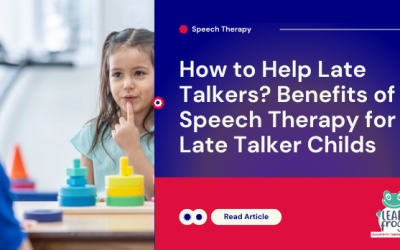Late talkers are children who do not speak by the usual milestones, typically not using 50 words or two-word combinations by age two.
Add your feed to SetSticker.com! Promote your sites and attract more customers. It costs only 100 EUROS per YEAR.
Pleasant surprises on every page! Discover new articles, displayed randomly throughout the site. Interesting content, always a click away
Leapfrogs
We're Not Just Therapists, We're Family10 Parenting Tips on How to Support a Child with Dyslexia 11 Oct 2024, 11:41 am
Navigating the challenges of parenting a child with dyslexia can be daunting, but with the right strategies, you can create a supportive and encouraging environment that fosters learning and growth. In this blog post, we will explore what dyslexia is, its causes, early signs, and effective tips on how to help a child with dyslexia thrive.
What is Dyslexia?

kid with dyslexia drawing with pencil and child psychologist looking at it
Dyslexia is a common learning difficulty that primarily affects reading and language processing. It can make reading, spelling, writing, and sometimes even speaking challenging. Dyslexia is not a reflection of intelligence; many children with dyslexia are bright and capable, but they may require different approaches to learning. Understanding dyslexia is crucial for parents to help their child succeed academically and emotionally.
How is Dyslexia Diagnosed?
Diagnosing dyslexia typically involves a comprehensive evaluation by educational psychologists or speech and language therapists. The process may include standardized tests to assess reading, writing, and phonological skills. Teachers and parents also provide valuable insights into the child’s academic performance and behaviour in the classroom. Early diagnosis is essential, as it allows for timely intervention that can significantly improve outcomes.
Early Signs of Dyslexia

Dyslexia Treatment. Therapist Working with Boy in Room
Recognising the early signs of dyslexia can help parents seek assistance sooner rather than later. Some indicators may include:
- Difficulty learning and recognising letters and sounds.
- Struggling with rhyming words.
- Trouble remembering the names of letters and the order of the alphabet.
- Difficulty sequencing or organising information.
- Avoiding reading and writing activities.
If you notice these signs, it may be time to consult a professional for a comprehensive evaluation.
Not a Result of Laziness
It is important to understand that dyslexia is not a result of laziness or lack of effort. Children with dyslexia may struggle with reading and writing despite trying their hardest. This learning difficulty is neurobiological, meaning it relates to how the brain processes language and is often hereditary. Parents should be patient and supportive, providing encouragement rather than placing blame.
What Causes Dyslexia?
Dyslexia can result from various factors, including genetics, differences in brain structure and function, and environmental influences. While the exact cause is not fully understood, research suggests that it often runs in families. Understanding these underlying factors can help parents better support their child with dyslexia.
10 Parenting Tips on How to Support a Child with Dyslexia

Dyslexia Treatment. Speech Therapist Holding Cube While Working
- Read Together Daily
Make reading a daily routine. Share bedtime stories and discuss the plot and characters. This promotes a love for books and helps improve comprehension. Choose engaging stories that capture your child’s interest and ask questions to encourage critical thinking. - Utilise Audiobooks
Allow your child to listen to audiobooks. This helps improve listening skills and understanding of story structure without the pressure of reading text. You can find many audiobooks that cater to children, making it easier to find engaging content for your child. - Create a Reading-Friendly Environment
Designate a quiet, comfortable space for reading. Ensure good lighting and access to a variety of books, including those with visuals to aid comprehension. This space should be free from distractions, allowing your child to focus on their reading. - Incorporate Visual Aids
Use charts, pictures, and flashcards to enhance learning. Visual aids can help reinforce concepts and make learning more engaging. For instance, using pictures alongside words can help your child connect images with language. - Teach Phonics Systematically
Focus on phonics and sound recognition through structured lessons. Use games and interactive activities to make learning fun and effective. For example, playing rhyming games can enhance phonetic awareness, helping your child decode words more easily. - Encourage Creative Writing
Provide opportunities for writing through journals, lists, or simple storytelling. Focus on ideas rather than spelling to foster creativity. Allow your child to express themselves without fear of making mistakes, creating a positive association with writing. - Leverage Technology
Use educational apps and tools specifically designed for children with dyslexia. These can provide interactive and engaging ways to learn. Many apps offer games and exercises that make learning enjoyable while reinforcing important skills. - Practice Patience and Encouragement
Celebrate small victories and encourage your child. Remind them that everyone learns at their own pace, and their efforts are what truly matter. Avoid comparing their progress to others, as this can lead to frustration and decreased motivation. - Seek Professional Support
Collaborate with educators and specialists who understand dyslexia. They can offer tailored strategies and resources for your child. Regular check-ins with these professionals can help track progress and adjust approaches as necessary. - Stay Informed and Advocate
Learn about dyslexia and effective teaching methods. Understanding how to teach a child with dyslexia can empower you as a parent. Be proactive in advocating for your child’s needs in school and seek additional resources when necessary.
How to Help a Child with Dyslexia at Home

Dyslexia Treatment. Speech Therapist Working with Girl in Room
In addition to these tips, there are specific strategies for parents to implement at home to reinforce learning:
- Establish a Routine
Consistent routines can provide structure, making it easier for children to understand what to expect and when to complete tasks. Routines can help reduce anxiety and create a more predictable environment. - Use Multisensory Techniques
Engage multiple senses in learning activities. For example, use sandpaper letters for tactile learning or visual materials to support auditory instruction. This approach can enhance memory retention and understanding. - Be a Source of Support
Regularly check in with your child about their feelings regarding reading and school. Provide emotional support and encouragement, reinforcing that they are not alone in their struggles.
We are Here to Help
Supporting a child with dyslexia requires understanding, patience, and a willingness to adapt your parenting strategies. By recognising the unique challenges associated with dyslexia and implementing these tips, you can create a nurturing environment that encourages learning and growth. Remember, it’s essential to advocate for your child and seek help when needed, ensuring they have the best possible support system in place.
If you’re looking for more resources or professional support, contact LeapFrogs today! Our team is dedicated to helping children with dyslexia reach their full potential.
How to Help Late Talkers? Benefits of Speech Therapy for Late Talker Childs 11 Oct 2024, 11:22 am
As therapists and speech pathologists working with young children at LeapFrogs, we often hear concerns like, “My child isn’t talking yet. Is that a problem? Is it my fault?” These questions reflect the anxiety many parents feel as they navigate their child’s development. It’s important to understand that the answer is nuanced. While some children may simply be late talkers who catch up over time, others may benefit from early intervention. Gaining insight into your child’s speech development is crucial for addressing concerns and fostering effective communication skills.
Who Are Late Talkers?

Speech therapist and little patient training articulation
Late talkers are children who do not speak by the usual milestones, typically not using 50 words or two-word combinations by age two. This delay can be concerning for parents, especially when they wonder, “What is considered a late talker?” Research suggests that 13-20% of two-year-olds may fall into this category, but they do not have a specific diagnosis like autism spectrum disorder or hearing loss.
When Do Late Talkers Start Talking?
Parents frequently ask, “When do late talkers start talking?” While the average age for speech development varies, many children begin using meaningful words by 12 to 18 months. If you find yourself questioning, “At what age do late talkers talk?” it’s important to remember that some children may need additional support to reach their milestones.
Will My Late Talker Grow Out of It?

Speech Therapist Working with Cute Girl in Clinic
Interestingly, around 50% of late talkers will eventually “outgrow” their language difficulties. However, relying solely on a “wait-and-see” approach can be problematic. Many late talkers may not catch up fully, leading to potential challenges in literacy and social skills in later years. Moreover, children with few words might display frustration or withdrawal, impacting their interactions and participation in family and school life.
Home Remedies for Late Talking Child
Parents seeking how to help late talkers can start by incorporating simple, practical activities at home:
- Engage in Conversation: Encourage your child to express themselves through open-ended questions and active listening.
- Read Together: Choose books with repetitive language to build vocabulary.
- Model Speech: Use clear, simple sentences, and emphasize new words.
These simple things to help with speech delay can be a game-changer in your child’s communication journey.
Speech Delay Activities
Incorporating speech delay activities can greatly enhance language skills:
- Playtime Communication: Use play to encourage dialogue. Describe what you’re doing, fostering a language-rich environment.
- Visual Aids: Incorporate pictures or visual planners to help your child express their needs.
- Storytime Engagement: Read books together and ask open-ended questions about the story to promote conversation and comprehension.
- Sing Songs and Rhymes: Use music to introduce rhythm and vocabulary, encouraging your child to sing along.
- Role-Playing: Create scenarios that require communication, such as playing restaurant or doctor, to practice conversational skills.
- Interactive Games: Use games like Simon Says to encourage listening and following directions, integrating vocabulary practice in a fun way.
The Role of Speech Therapy

Children speech therapy concept. Preschooler practicing correct pronunciation with a female speech therapist.
When asking, “How to fix speech delay?” consider consulting a speech therapist. Professional intervention can provide targeted strategies for how to help your child talk. Speech therapy offers tailored support and training for parents, focusing on recognizing and encouraging various forms of communication.
One of the primary benefits of speech therapy is that it addresses the unique needs of each child. A qualified speech therapist assesses your child’s specific communication challenges and develops a personalized plan to promote language development. This individualized approach allows for targeted exercises and strategies that align with your child’s interests and learning style, making the process engaging and effective.
Importantly, a systematic review of intervention studies found that 93% reported improvements in expressive vocabulary for late talkers. This evidence highlights the effectiveness of early intervention. Speech therapy not only works on vocabulary but also helps with pronunciation, sentence structure, and social communication skills. Additionally, it fosters confidence in children, encouraging them to communicate more freely without the fear of judgment or misunderstanding.
Through consistent therapy sessions, children gain valuable tools to express their needs, thoughts, and feelings. They learn to use language in various contexts, improving their overall communication skills, which is essential for success in both academic and social settings.
Conclusion
If your child isn’t talking as much as their peers, seeking support is invaluable. There’s no evidence that parents are the cause of late talking; however, early intervention can make a significant difference. By understanding your child’s needs and implementing effective strategies, you can help pave the way for their speech development. If you’re concerned about your child’s communication skills, it’s definitely worth looking into.
For additional support, contact LeapFrogs today!
Learning Disorders In Children | What Are The Signs and Steps To Take 11 Oct 2024, 6:02 am
Learning disorders can significantly impact a child’s educational journey, but early intervention can make a world of difference. Learning disorders in children are often misunderstood as a single issue when, in fact, they cover a broad spectrum.
Learning disabilities can manifest in various areas, such as reading (dyslexia), mathematics (dyscalculia), and even in working memory or thought organization. It is estimated that 1 out of every 5 children will have some form of learning disability with boys being twice as likely to develop some form of learning difficulty as they enter pre-school.
Recognising early signs of learning disability and taking the appropriate steps are crucial for a child’s development.
What is a Learning Disability?

A learning disorder refers to a neurological condition that affects a child’s ability to process, store, or communicate information. It doesn’t mean the child is less intelligent; instead, their brain processes information differently, leading to learning difficulties. The causes of learning disabilities often include a mix of genetic, neurological, and environmental factors. While learning disabilities are lifelong, early support can significantly improve a child’s skills and confidence.
Types of Learning Disabilities
- Dyslexia: Difficulty in reading, including problems with fluency, decoding, and comprehension.
- Dyscalculia: Challenges with understanding numbers and mathematical concepts.
- Working Memory Issues: Difficulty retaining and using information, impacting planning, reasoning, and problem-solving.
- Dysgraphia: Struggles with writing, including poor handwriting and difficulty organising thoughts on paper.
These conditions all fall under the umbrella of learning deficiency but can vary greatly from one child to another.
Early Signs of Learning Disorders

Teacher working with students with disabilities at class
Recognising the symptoms of learning disability early can help ensure children get the support they need. Common early signs include:
- Difficulty understanding and following instructions.
- Problems with reading or grasping mathematical concepts.
- Poor memory and attention span.
- Struggles to organise thoughts or keep track of time.
- Avoidance of tasks that require sustained attention or effort.
If you’re asking, “Does my child have a learning disability?” it’s important to pay attention to these signs and consult a professional if concerns persist.
What Causes Learning Disabilities?
There’s no single answer to what causes learning disabilities, but contributing factors may include:
- Genetics: Children with a family history of learning disabilities are more likely to develop them.
- Brain Development: Abnormalities in brain structure or function can impact learning abilities.
- Environmental Factors: Exposure to toxins during pregnancy, premature birth, or head injuries can all influence brain development.
By understanding the causes of learning disability, parents can better support their child in overcoming challenges.
How to Diagnose Learning Disability in a Child

Art education for disabled children
If you suspect your child may have a learning disability, early assessment is crucial. Here are the steps you should take:
- Assessment by a Therapist or Clinical Psychologist: A licensed therapist or clinical psychologist can conduct comprehensive testing to evaluate your child’s cognitive and learning abilities. They may use standardised assessments to diagnose specific issues.
- Consult a Special Education Teacher: Special education professionals are skilled in working with children with learning difficulties. They can provide recommendations for classroom accommodations and learning strategies.
- Create an Individualised Plan: Once a diagnosis is confirmed, develop an action plan with your child’s school and therapists to ensure they receive the support they need.
These steps are fundamental in understanding how to diagnose learning disability in child and ensuring they have the right resources to succeed.
What Can Parents Do at Home?
In addition to professional help, there are many ways parents can support a child with a learning disorder at home:
- Create a Structured Routine: Children with learning disabilities often thrive on routine. Make sure your child knows what to expect daily.
- Use Visual Aids: Visual planners or charts can help children better understand tasks and time management.
- Break Tasks Down: Large tasks can feel overwhelming, so breaking them into smaller, more manageable steps can help your child feel more confident.
- Encourage Positive Reinforcement: Celebrate small achievements to build your child’s self-esteem.
- Provide a Quiet, Distraction-Free Workspace: A designated area for homework can reduce distractions and help your child focus.
Conclusion
Learning disorders can be challenging, but with early identification and proper intervention, children can thrive academically and emotionally. By understanding the causes of learning disability and recognising the signs of learning disability, parents can ensure their child receives the support they need. If you suspect your child may have a learning disorder, don’t hesitate to seek professional assessment and work closely with therapists and educators to create an individualised plan for success.
If you need further support or want to assess your child’s learning development, reach out to LeapFrogs to learn more about how we can help! Remember that a diagnosis is crucial, but it does not seal your child’s future. With proper intervention and early education, your child can thrive despite difficulties!
How to Help Your Children Thrive by Establishing a Predictable Routine? 10 Oct 2024, 7:13 pm
Establishing routines for children is a vital way to provide them with a sense of security and confidence as they grow. From bedtimes to homework schedules, routines create a structure that allows children to feel safe, organised, and better able to predict what will happen next. In this blog post, we’ll explore why routines are important for children, review research on their benefits, and provide practical tips on creating a routine that helps your child thrive.
Why Are Routines Important for Children?

Children thrive in environments that support creativity and curiosity
Children thrive when they have routines because it provides them with predictability and stability. When children understand what to expect throughout the day, they feel more secure, which helps them manage their emotions and focus on the tasks at hand. Routines teach children how to organise their time, reduce stress, and develop a sense of responsibility.
Key benefits of routines for children include:
- Security: Predictable routines give children a sense of safety and help them understand their environment.
- Emotional regulation: Consistent routines reduce anxiety, enabling children to manage their feelings more effectively.
- Improved sleep patterns: A structured bedtime routine encourages healthy sleep habits, which are crucial for growth and development.
- Greater independence: As children follow daily routines, they learn to complete tasks on their own, fostering responsibility.
What Research Says About the Importance of Routines for Children

Children’s creativity thrive in open-ended play, like building sandcastles
Numerous studies in thrive child psychology highlight the importance of routines in a child’s emotional and behavioural development.
One significant study published in the Journal of Developmental & Behavioral Pediatrics found that children with regular household routines displayed better social and emotional health. The study concluded that children with consistent routines were less likely to exhibit hyperactivity and disruptive behaviour, and had higher levels of social competence and emotional stability.
Another study, from The American Academy of Pediatrics, noted that family routines were associated with higher academic performance in children. Those with structured routines, such as fixed bedtimes and mealtimes, were found to have better cognitive development and attention spans.
In contrast, research from The Journal of Family Psychology examined children raised without routines and found that these children were more prone to anxiety, mood swings, and attention difficulties. Without a structured environment, they struggled with predictability, which affected their ability to regulate emotions and focus on tasks.
What Do Children Need to Thrive?
Children thrive when they have routines that provide a predictable structure. Predictability helps them navigate their day without feeling overwhelmed or anxious. Whether it’s knowing what happens next in their daily schedule or the comfort of a nightly bedtime routine, children benefit from environments that are consistent.
Key areas where routines make a difference include:
- Bedtime routines: Consistent activities, such as brushing teeth, reading a book, and going to bed at the same time each night, signal to children that it’s time to wind down and prepare for sleep.
- Morning routines: Structured morning activities like getting dressed, brushing teeth, and having breakfast help children start their day with a sense of readiness and calm.
- Homework routines: Setting a specific time and place for homework ensures that it becomes part of the child’s daily rhythm, promoting discipline, focus, and productivity.
Visual Planners: Helping Children Understand What Comes Next

To support routines, especially for younger children, visual planners can be incredibly helpful. These planners provide a visual representation of the child’s daily tasks, helping them know what to expect. For instance, pictures showing tasks such as “brush teeth,” “do homework,” or “bedtime” act as cues for each part of the day. This not only keeps children engaged but also empowers them to take control of their routine.
Flexibility Within Routine
While routines are beneficial, it’s essential to balance them with flexibility. Life can sometimes be unpredictable, and teaching children to adapt within the framework of a routine helps build resilience. When changes occur, communicate them to your child in advance to reduce anxiety and ensure they feel prepared.
Final Thoughts on Helping Your Child Thrive
Establishing routines for children goes beyond keeping order — it’s about providing them with the structure they need to grow and succeed. Whether it’s implementing bedtime routines, morning schedules, or using visual planners, helping children understand what’s coming next can lead to a more confident, secure, and thriving child.
Children thrive when they have routines that make their world feel safe and predictable, enabling them to focus on exploring, learning, and growing. As research shows, routine is not just about discipline — it’s a powerful tool in helping your child thrive both emotionally and developmentally.
Please feel free to reach out to us at LeapFrogs if you need further help establishing routines for your child! We will be happy to help.
Identifying The Signs Of Dyslexia in Early Ages [3 Steps] 13 Sep 2024, 6:11 am
Early detection is key, as the sooner it is identified, the quicker interventions can be put in place to help children adapt to their learning environment.
What is Dyslexia?

Desperate child with dyslexia in front of a whiteboard with flying letters at school
Dyslexia primarily affects reading, impacting a child’s ability to recognise and decode words. It can lead to struggles with spelling, reading fluency, and comprehension. Importantly, dyslexia is not a result of poor teaching, vision problems, or a lack of intelligence—it’s a neurological difference in the brain that affects how language is processed.
Children with dyslexia often learn to manage their symptoms with the appropriate support but will continue to face challenges throughout their lives. Early identification of dyslexia in children can make a significant difference in their learning journey and overall confidence.
Debunking Myths Around Dyslexia
A common myth is that reversing letters, such as confusing ‘b’ and ‘d,’ is a clear sign of dyslexia in kids. However, many children go through this stage as part of normal development, and it is not a definitive marker of the condition.
Dyslexia is far more complex and goes beyond simple letter reversals. It involves difficulties with phonological awareness (the ability to break down words into sounds) and can lead to struggles in reading fluency, spelling, and even writing. Recognising the signs of dyslexia early on is crucial to ensuring children receive the right support as they begin their learning journey.
When is Dyslexia Diagnosed?

Dyslexia Concept. Little Boy Holding Paper with Word Help at Woo
Parents may begin noticing early signs of dyslexia in their children as young as preschool age, though a formal diagnosis is usually made around the age of 5 to 7. This is when children start learning foundational reading and writing skills, and any challenges become more apparent.
The signs of dyslexia in a 5 year old may include difficulty rhyming, recognising letters, or remembering sequences like the alphabet. However, some children may show signs even earlier. The signs of dyslexia in a 4 year old might include trouble with basic sound recognition or difficulty learning new words. In some cases, the signs of dyslexia in a 7 year old may become more noticeable when the gap between them and their peers widens in terms of reading and writing skills.
Who Can Diagnose Dyslexia?
Typically, educational psychologists or specialists in learning disabilities diagnose dyslexia. They conduct various assessments that evaluate a child’s phonological awareness, reading fluency, and other skills related to language processing. If parents suspect their child may have dyslexia, early intervention is crucial to prevent difficulties from compounding as their child progresses through school.
Three Actionable Steps for Parents

kid with dyslexia drawing with pencil and child psychologist looking at it
1. Recognise the Early Signs
As a parent, being aware of early signs of dyslexia in children is key. Look out for difficulties in recognising letters, sounding out words, poor spelling, or a reluctance to read aloud. Symptoms of dyslexia in children can also include trouble following sequences, such as reciting the alphabet or remembering days of the week. The sooner these signs are identified, the quicker you can seek professional help.
2. Seek Professional Help
If you notice any signs of dyslexia in your child, such as difficulty reading or recognising letters, it’s essential to consult a specialist. Educational psychologists and speech-language therapists can carry out detailed assessments to determine whether your child has dyslexia. Early diagnosis allows for timely intervention, ensuring your child receives the support they need.
3. Adjust Teaching Approaches
Teaching methods must be adapted to fit the learning style of children with dyslexia. Standard classroom approaches may not be effective for these children, and instead, they benefit from multisensory learning techniques. This includes methods where children can see, hear, and physically engage with the material. As the quote beautifully summarises, “If a child cannot learn the way we teach, then maybe we need to change the way we teach and not how the child learns.”
Dyslexia: A Lifelong Condition
Dyslexia is a lifelong condition; children will not “outgrow” it. However, with the right strategies and support, they can develop ways to work around their difficulties and manage their challenges effectively. Schools, teachers, and parents need to remain flexible, offering continuous learning support throughout the child’s academic journey.
By understanding the early signs of dyslexia and seeking early intervention, parents can ensure their child gets the necessary tools and support. The earlier dyslexia in children is identified, the better the outcome for the child’s learning development and long-term success.
Final Words
Recognising the signs of dyslexia in kids at an early stage is crucial for ensuring they receive the help they need. If you notice early signs of dyslexia in your 4-year-old, 5-year-old, or even 7-year-old, don’t hesitate to seek a formal evaluation. With proper support and teaching adjustments, children with dyslexia can thrive academically and develop the skills they need to succeed. While dyslexia in children is a lifelong condition, with early intervention, they can be empowered to overcome the challenges they face.
Get Professional Support at LeapFrogs
If you’re concerned about your child showing signs of dyslexia or other learning difficulties, Leap-Frogs is here to help.
Our experienced team of educational specialists can guide you through the process, offering comprehensive assessments and tailored support to meet your child’s unique learning needs.
Contact us today at Leap-Frogs to learn more about how we can support your child’s learning journey. Remember, dyslexia should not determine your child’s future success. Let us help them thrive despite this learning disability!
Categories
Related Articles
Learning Disorders In Children | What Are The Signs and Steps To Take
Learning disabilities can manifest in various areas, such as reading (dyslexia), mathematics (dyscalculia), and even in working memory or thought organization. It is estimated that 1 out of every 5 children will have some form of learning disability with boys being twice as likely to develop some form of learning difficulty as they enter pre-school.
How to Help Your Children Thrive by Establishing a Predictable Routine?
In this blog post, we’ll explore why routines are important for children, review research on their benefits, and provide practical tips on creating a routine that helps your child thrive.
What is Autism Spectrum Disorder For Kids (ASD)? Causes, Symptoms & Treatment 12 Sep 2024, 2:00 pm
What is Autism?
 Autism Spectrum Disorder (ASD) is a lifelong developmental condition that impacts how children perceive the world and interact with those around them. What makes someone autistic is not related to intelligence or upbringing but rather the way their brain processes information. Children with autism may have challenges with social communication, exhibit repetitive behaviours, and struggle with changes in routine.
Autism Spectrum Disorder (ASD) is a lifelong developmental condition that impacts how children perceive the world and interact with those around them. What makes someone autistic is not related to intelligence or upbringing but rather the way their brain processes information. Children with autism may have challenges with social communication, exhibit repetitive behaviours, and struggle with changes in routine.
Common Myths About Autism
In the past, autism was sometimes attributed to poor parenting, particularly the cold or distant parenting style known as “refrigerator parenting.” Thankfully, this theory has been thoroughly debunked. Today, we know that autism is a neurodevelopmental condition, not the result of cold or inattentive parents. It’s also essential to debunk the myth that all children with autism are the same. Autism manifests differently in each child, which is why it is classified as a spectrum disorder.What is Autism Caused By?
The question what is autism caused by has intrigued researchers for years. Currently, there is no single identified cause of autism. Scientists believe that a combination of genetic and environmental factors may contribute to the development of the disorder. While there is no prenatal test to diagnose autism, research is ongoing to understand how both genes and environmental influences may interact to trigger the condition.Recognising the Symptoms of Autism by Age

Signs of Autism in Babies and Toddlers
Early signs of autism can be subtle, and parents often begin noticing them during infancy or the toddler years. Some signs of an autistic child at age 2 include:- Lack of eye contact or reduced engagement with caregivers
- Limited response to their name
- Delayed speech or lack of babbling
- Little interest in social games like peek-a-boo
- Avoiding physical contact or showing resistance to being cuddled
Signs of Autism at Age 3
By age 3, many of the developmental milestones around communication and social interaction are becoming more apparent. Here are some signs of an autistic child at age 3:- Difficulty playing with others or showing interest in peers
- Unusual reactions to sensory input (e.g., covering ears at loud noises or showing sensitivity to textures)
- Engaging in repetitive movements or speech patterns (e.g., flapping hands, repeating the same phrase)
- Trouble understanding emotions, both their own and others’
- Resistance to changes in routine or becoming distressed by minor changes in the environment
Signs of Autism at Age 4
By the time children reach the age of 4, social interaction becomes even more critical as they prepare for school. Some signs of autism in toddlers age 4 include:- Difficulty initiating conversations or engaging in back-and-forth dialogue
- Limited imaginative play (e.g., not engaging in role-play or pretending)
- Fixating on specific interests, such as lining up toys in a particular order
- Limited or unusual facial expressions when communicating
- Difficulty understanding social cues, such as turn-taking in conversation or playing games with others
Signs of Autism in Older Children
While many signs of autism emerge in the early years, some children may not show clear symptoms until later in their childhood. Signs of autism in kids aged 5 and above might include:- Struggles with making friends or participating in group activities at school
- Difficulty understanding metaphors, jokes, or figures of speech
- Strong adherence to routines, with resistance to change
- Difficulty recognising or expressing emotions appropriately
- Engaging in repetitive or obsessive behaviours, such as counting objects repeatedly or following rigid routines
How is Autism Diagnosed?
 Autism is a complex condition with no single diagnostic test. Neuropsychologists, child psychiatrists, and developmental paediatricians use a combination of interviews, observations, and structured assessments to diagnose autism.
Typically, the diagnosis involves evaluating how a child communicates, behaves, and interacts with others. Parents will often complete questionnaires detailing their child’s developmental history, and healthcare professionals will observe the child in various settings. For parents wondering when is autism diagnosed, it is often identified between ages 2 and 4, but some children are diagnosed later.
Autism is a complex condition with no single diagnostic test. Neuropsychologists, child psychiatrists, and developmental paediatricians use a combination of interviews, observations, and structured assessments to diagnose autism.
Typically, the diagnosis involves evaluating how a child communicates, behaves, and interacts with others. Parents will often complete questionnaires detailing their child’s developmental history, and healthcare professionals will observe the child in various settings. For parents wondering when is autism diagnosed, it is often identified between ages 2 and 4, but some children are diagnosed later.
Autism is a Lifelong Condition
It’s important for parents to understand that autism is a lifelong condition. While early intervention and treatment can significantly improve a child’s ability to function in various areas, autism does not “go away.” Children with autism grow into adults with autism, and they will continue to face unique challenges throughout their lives. The good news is that with the right support, individuals with autism can lead fulfilling lives. A kid with autism can learn strategies to work around their challenges and build on their strengths, whether that means developing strong skills in a particular area of interest or learning to communicate more effectively with others.How is Autism Diagnosed?
Autism is a complex condition with no single diagnostic test. Neuropsychologists, child psychiatrists, and developmental paediatricians use a combination of interviews, observations, and structured assessments to diagnose autism. Typically, the diagnosis involves evaluating how a child communicates, behaves, and interacts with others. Parents will often complete questionnaires detailing their child’s developmental history, and healthcare professionals will observe the child in various settings. For parents wondering when is autism diagnosed, it is often identified between ages 2 and 4, but some children are diagnosed later.Treatment Options for Autism
While autism is a lifelong condition, early intervention can significantly improve a child’s development and quality of life. Autism treatment is highly individualised and depends on the child’s unique needs. Here are some common treatments for children with autism:1. Speech Therapy
Many children with autism benefit from speech therapy, particularly in improving their ability to communicate verbally. Speech therapists focus on helping children develop their vocabulary, understand grammar, and use language for social purposes (pragmatics).2. Play Therapy
Play therapy helps children learn essential social skills through structured activities. It can be especially effective in teaching children how to share, take turns, and express themselves more clearly during interactions with their peers.3. Psychotherapy
Children with autism may develop anxiety, phobias, or obsessive-compulsive behaviours. Psychotherapy can help them manage these emotions and develop coping strategies. Cognitive-behavioural therapy (CBT) is one type of therapy that is often used to address anxiety and repetitive behaviours.4. Educational Therapy
Children with autism may require adjustments in their learning environments. Educational therapy focuses on tailoring teaching methods to the child’s specific needs, often incorporating visual aids, step-by-step instructions, and hands-on learning.5. Physical Therapy
Some children with autism may also have difficulties with motor skills. Physical therapy can improve coordination, balance, and muscle strength, helping children navigate their environment more easily.Autism is a Spectrum: Levels of Functioning
Autism affects each child differently. Some children may have high-functioning autism, where they can communicate effectively but struggle with social cues, while others may be non-verbal or require significant support with daily activities. It’s essential to understand that autism is a spectrum, and each child will have their own strengths and challenges.Conclusion
Recognising the early signs of autism is crucial for helping children receive the support they need. If you’ve noticed any of the above signs of autism in toddlers age 4 or even earlier, it’s essential to consult a specialist for a formal evaluation. Early diagnosis and intervention can make a significant difference in a child’s life.Get Support at LeapFrogs
At LeapFrogs, we offer specialised services for children with autism, including speech therapy, play therapy, and more. If you’re concerned that your child may be showing signs of autism or have already received a diagnosis, our team of experts is here to help. We provide tailored therapy programmes designed to support each child’s unique needs. Contact us today at LeapFrogs to learn more about our autism treatment services and how we can assist your child on their developmental journey.Categories
Related Articles
How to Help Late Talkers? Benefits of Speech Therapy for Late Talker Childs
Late talkers are children who do not speak by the usual milestones, typically not using 50 words or two-word combinations by age two.
Learning Disorders In Children | What Are The Signs and Steps To Take
Learning disabilities can manifest in various areas, such as reading (dyslexia), mathematics (dyscalculia), and even in working memory or thought organization. It is estimated that 1 out of every 5 children will have some form of learning disability with boys being twice as likely to develop some form of learning difficulty as they enter pre-school.
How to Help Your Children Thrive by Establishing a Predictable Routine?
In this blog post, we’ll explore why routines are important for children, review research on their benefits, and provide practical tips on creating a routine that helps your child thrive.
What is Speech Therapy | A Guide on What is it & How it Works? 12 Sep 2024, 12:22 pm
In this comprehensive guide, we’ll delve into the meaning of speech therapy, what it entails, and explore some of the techniques used to help children communicate effectively.
What is Speech Therapy?

Children speech therapy concept. Preschooler practicing correct pronunciation with a female speech therapist.
Speech therapy, or speech and language therapy, involves the assessment and treatment of speech, language, and communication difficulties.
It focuses on improving a child’s ability to understand language, articulate words, and express thoughts and emotions clearly. For many parents, the question “what is speech therapy for child?” is a common one.
Essentially, it’s a tailored approach aimed at overcoming communication barriers that impact a child’s social, academic, or personal development.
Tell-Tale Signs Your Child May Need Speech Therapy
Parents may wonder when to seek speech therapy for children. While every child develops at their own pace, there are some signs that may suggest a need for intervention:
Difficulty pronouncing words or sounds
- Limited vocabulary for their age
- Struggles to form sentences
- Frustration when communicating
- Trouble with reading or following instructions
- Difficulty chewing or swallowing food
If you notice any of these signs, child speech therapy might be beneficial. A speech therapist will assess your child’s specific needs and recommend an appropriate treatment plan.
How Speech Therapy Works?

Children speech therapy concept. Preschooler practicing correct pronunciation with a female speech therapist.
Understanding “how speech therapy works” can help parents feel more confident in the process. A speech therapist will use various techniques to improve communication skills, focusing on different aspects such as:
- Phonetics: This involves working on the sounds of speech, helping children to pronounce words correctly.
- Semantics: Therapists teach the meanings of words and how to use them appropriately in different contexts.
- Pragmatics: This aspect focuses on the social use of language, helping children understand and follow conversational norms such as taking turns and making eye contact.
- Articulation: Many children struggle with articulating certain sounds, such as “r,” “s,” or “l.” A speech therapist will work on teaching correct sound production.
Oral Motor Activities
For children who experience difficulty eating, oral motor activities are a key part of speech therapy. These activities strengthen the muscles in the mouth, improving coordination for eating, speaking, and even breathing. Some common oral motor exercises include blowing bubbles, sucking through a straw, and chewing various textured foods to stimulate muscle activity.
Speech Therapy Techniques
Speech therapy incorporates a wide range of techniques tailored to the needs of each child. Some of these techniques include:
- Speaking therapy: This involves direct exercises to help children improve their verbal communication.
- Play-based therapy: Engaging younger children through play is an effective way to make learning fun while working on speech goals.
- Modelling: Therapists may demonstrate correct speech patterns and encourage children to imitate these.
- Repetition and reinforcement: By practicing words, sounds, and phrases repeatedly, children build familiarity and confidence.
What is a Speech Therapist?

Therapists – Leap Frogs
You may be asking yourself, “what is a speech therapist?” A speech therapist, or speech-language pathologist, is a specialist trained to assess and treat communication disorders. They work closely with parents to set goals and tailor their approach based on the child’s unique challenges, ensuring each child has the best chance of success.
Final Words
Speech therapy is a highly effective tool for helping children overcome communication difficulties and thrive both socially and academically. Understanding the meaning of speech therapy, the signs your child may need it, and the speech therapy techniques involved can provide peace of mind for parents.
At LeapFrogs, we are committed to supporting families and helping children reach their full potential through expert speech and language therapy. If you’re asking yourself, “what is speech therapy for?” or if your child might benefit from personalised child speech therapy, contact LeapFrogs today to schedule a consultation. Our team of experienced speech therapists is here to guide you and your child on the path to clearer communication and greater confidence.
Let’s take the leap together!
Categories
Related Articles
How to Help Late Talkers? Benefits of Speech Therapy for Late Talker Childs
Late talkers are children who do not speak by the usual milestones, typically not using 50 words or two-word combinations by age two.
Learning Disorders In Children | What Are The Signs and Steps To Take
Learning disabilities can manifest in various areas, such as reading (dyslexia), mathematics (dyscalculia), and even in working memory or thought organization. It is estimated that 1 out of every 5 children will have some form of learning disability with boys being twice as likely to develop some form of learning difficulty as they enter pre-school.
How to Help Your Children Thrive by Establishing a Predictable Routine?
In this blog post, we’ll explore why routines are important for children, review research on their benefits, and provide practical tips on creating a routine that helps your child thrive.
Understanding Mild Autism: Symptoms, Traits, and How It Manifests 12 Sep 2024, 9:39 am
Autism: An Umbrella Term

psychologist playing blocks with little child with autism syndrome
Mild Autism: Subtle Signs That Can Go Unnoticed
Mild autism refers to individuals who are on the higher-functioning end of the autism spectrum. Unlike those with more severe forms of autism, people with mild autism often have symptoms that may not be immediately obvious. Children may reach developmental milestones like walking and talking at the expected time, but subtle social and communication challenges begin to emerge, particularly as they interact with peers in structured environments like preschool. Parents may begin to worry when they notice their child struggles to engage in social play, maintain eye contact, or understand basic social cues. These symptoms can sometimes be mistaken for shyness or introversion, and may not be identified until the child is observed in a group setting.What is Considered Mild Autism?

Little boy with autistic disorder near color wall
- Social Interaction Challenges: Difficulty understanding social cues, making friends, or participating in group activities.
- Communication Issues: Delayed speech development or challenges in interpreting non-verbal communication, such as facial expressions and gestures.
- Repetitive Behaviours: Engaging in repetitive movements or having a preference for routine and consistency.
- Sensory Sensitivities: Over- or under-sensitivity to sensory stimuli, such as sounds, lights, or textures.
Mild Autism in Toddlers
Signs of mild autism can often begin to manifest in toddlers, particularly when they start interacting with others at playgroups or in preschool. Social differences may become more apparent as they engage with peers. Mild Signs of Autism in Toddlers Include:- Limited Eye Contact: Toddlers may avoid making eye contact during interactions or may not respond consistently when their name is called.
- Delayed Speech: Delayed language development is often one of the early signs. Toddlers with mild autism may speak fewer words than expected for their age.
- Preference for Solitude: They may prefer to play alone or engage in parallel play (playing alongside other children without interacting with them).
- Fixation on Objects: Toddlers with mild autism may become fixated on certain toys or objects and engage in repetitive play.
Mild Autism Symptoms in a 1-Year-Old
 Detecting autism in a 1-year-old can be challenging, as developmental variability is common at this age. However, early signs of mild autism may be observed in subtle behaviours:
Detecting autism in a 1-year-old can be challenging, as developmental variability is common at this age. However, early signs of mild autism may be observed in subtle behaviours:
- Lack of Response to Name: By their first birthday, most children will respond to their name being called. A child with mild autism may not.
- Limited Gestures: A child with mild autism may show fewer gestures like pointing, waving, or clapping.
- Minimal Social Smiling: While most 1-year-olds smile in response to social interaction, those with mild autism may smile less or not initiate social smiles.
Symptoms of Mild Autism in 2-Year-Olds
By the age of two, mild autism symptoms can become more noticeable as language and social milestones become more advanced.- Speech Delays: A 2-year-old with mild autism may speak fewer words than their peers or may repeat phrases (known as echolalia) instead of generating original sentences.
- Repetitive Play: They may play with toys in a repetitive manner, such as lining up cars or building structures the same way repeatedly.
- Lack of Imitation: Most toddlers enjoy mimicking adults, such as pretending to cook. A child with mild autism may not engage in this type of pretend play.
Mild Autism Symptoms in 4-Year-Olds
At age four, children typically engage more in group play and develop deeper social connections. Children with mild autism may struggle to keep up with these developmental milestones.- Difficulty in Social Play: A 4-year-old with mild autism may prefer solitary activities or engage in parallel play rather than joining group games.
- Literal Thinking: They may struggle to understand jokes, sarcasm, or metaphors.
- Resistance to Change: Changes in daily routines, such as a new seating arrangement or schedule, may cause them distress.
Mild Autism Symptoms in 5-Year-Olds
By five years old, mild autism symptoms may continue to be evident in social and communication challenges, particularly in structured settings like school.- Challenges in Making Friends: A 5-year-old with mild autism may find it difficult to form friendships or understand social rules, like sharing or taking turns.
- Rigid Thinking Patterns: They may insist on strict routines and become upset when routines are disrupted.
- Sensory Sensitivities: They might show aversion to certain textures, loud sounds, or bright lights, which could affect daily functioning.
Mild Autism Symptoms in Adults
Adults with mild autism, many of whom may not have been diagnosed as children, often adapt to their social environments. However, they may still face challenges.- Social Anxiety: Navigating social situations can be challenging due to difficulties with reading social cues.
- Difficulty with Change: Adults with mild autism may struggle with unexpected changes and find comfort in routines.
- Intense Interests: Many adults with mild autism have specialised interests or hobbies that they pursue with great passion and focus.
Mild Autism: How to Support Your Child
While there is no cure for autism, early intervention can significantly improve a child’s social, communication, and behavioural skills. If you suspect your child has mild autism, seeking a diagnosis from a child psychiatrist or neurologist is the first step.Tips for Supporting a Child with Mild Autism:
- Children with mild autism thrive on routine, and a structured environment helps them feel secure.
- Introduce your child to group activities gradually, encouraging them to practice social skills.
- Many children with mild autism respond well to visual tools like schedules, charts, or picture books to help them understand daily routines.
Trust LeapFrogs for Comprehensive Support
Mild autism presents a range of subtle symptoms that can sometimes be overlooked, but understanding these traits is crucial for providing effective support. Early intervention, including play and speech therapies, can make a significant difference in a child’s development. Play therapy is particularly beneficial for children with mild autism as it helps them improve social interaction skills. Through structured play, children learn essential social cues such as turn-taking, managing winning and losing gracefully, waiting for their turn, and respecting others’ boundaries. These skills are vital for successful peer interactions and overall social development. Similarly, speech therapy addresses challenges with understanding language that is not meant to be taken literally. Children with mild autism may struggle with idiomatic expressions, metaphors, or phrases that have no literal meaning, like “it’s raining cats and dogs.” Speech therapy helps them grasp these concepts and improves their ability to interpret and use language effectively in various social contexts. At LeapFrogs, we are committed to offering comprehensive, family-oriented support tailored to each child’s needs. By incorporating play and speech therapy, we help children with mild autism develop the skills they need to thrive in social settings and navigate everyday interactions with greater confidence.Categories
Related Articles
How to Help Late Talkers? Benefits of Speech Therapy for Late Talker Childs
Late talkers are children who do not speak by the usual milestones, typically not using 50 words or two-word combinations by age two.
Learning Disorders In Children | What Are The Signs and Steps To Take
Learning disabilities can manifest in various areas, such as reading (dyslexia), mathematics (dyscalculia), and even in working memory or thought organization. It is estimated that 1 out of every 5 children will have some form of learning disability with boys being twice as likely to develop some form of learning difficulty as they enter pre-school.
How to Help Your Children Thrive by Establishing a Predictable Routine?
In this blog post, we’ll explore why routines are important for children, review research on their benefits, and provide practical tips on creating a routine that helps your child thrive.


